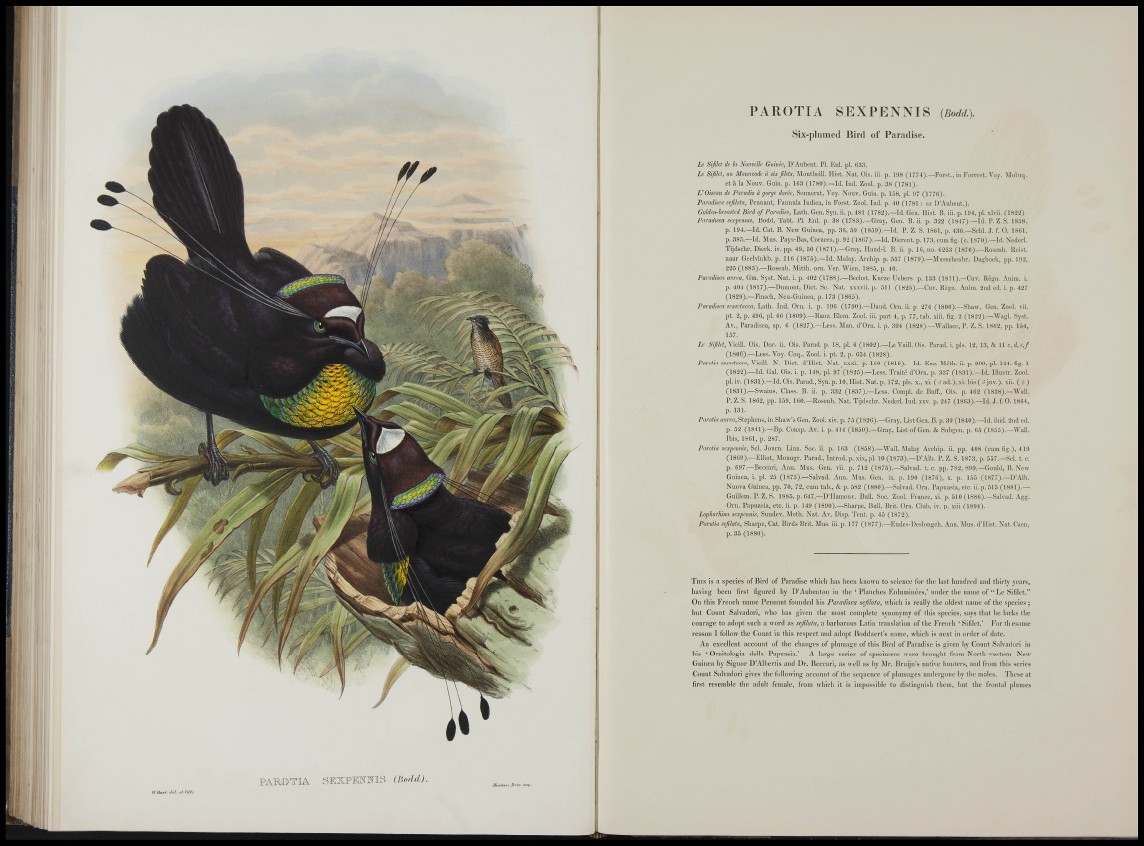
I ||
f-i
f ' i
, fH-
: I
ij| <1
,i| 1; I
PAROTIA SEXPENNIS (BoM.).
Six-plnmed Bird of Paradise.
Le Sifikt de la Notivelk Guinee, D'Aubent. PI. Eni. pi. 033.
Le Sifikt, ou Manucode à sin filets, Moatbeill. Hist. Nat, Ois, iii. p. 198 (1774).—Forst., in Fori-est, Voy. Molui).
et à la Nouv. Gnin. p. 103 (1780).—Id. Ind. Zool. p. 38 (1781).
L'Oiseau de Paradis à gorge dorce, Sonnerat, Voy. Nouv. Guiu. p. 158, pL !)7 (1770).
Paradisea sefilata, Pennant, Faunula Indica, in Forst. Zool. Ind. p. 40 (1781 ; ex U'Aubent.).
Golden-lreasted Bird of Paradise, Lath. Gen. Syn. ii. p. 481 (1782),—Id. Gen. Hist. B. iii. p. 1!)4, pi. xlvii. (1822)
Paradisea sexpennis, Bodd, Tabi. PI. Eni. p. 38 (1783).—Gray, Gen. B. ii. p. 323 (1847).—Id. P. Z.S. 1858,
p. 194.—Id. Cat. B. New Guinea, pp. 30, 6!) (185!)).—Id. P. Z. S. 18C1, p. 430.—Schl. ,1. f. 0 . 1801,
p. 385.—Id. Mus. Pays-Bas, Coraces, p. 92 (1867).—Id. Dierent. p. 173, cum fig. (c. 1870).—Id. Nederl.
Tijdschr. Dierii. iv. pp. 49, 50 (1871).—Gray, Hand-1. B. ii. p. 10, no. 0263 (1870).—Roscnb. Rcist.
naar Geelvinkb. p. 110 (1875).—Id. Malay. ArcMp. p. 557 (1879).—Musschenbr. Dagboel<, pp. 192,
225 (1883).—Rosenb. Mitth. orn. Ver. Wien, 1885, p. 40.
Paradisea aurea, Gm. Syst. Nat. i. p. 402 (178S).—Beehst. Kurze Uebers. p. 133 (1811).—Cnv. Règn. Anim. i.
p. 404 (1817).—Dumont, Diet. Sc. Nat. xxxvii. p. 511 (1825).—Cnv. Règn. Aniin. 2nd ed. i. p. 437
(1829).—Finscli, Nen-Gninea, p. 173 (1865).
Paradisea sexsetacea. Lath. Ind. Orn. i. p. 190 (1790).—Daud. Orn. ii. p, 270 (1800).—Shaw, Gen. Zool. vii.
pt. 2, p. 490, pi. 60 (1809).—Ranz. Elem. Zool. iii. part 4, p. 77, tab. xiii. fig. 2 (1822).—Wagl. Syst.
Av., Paradisea, sp. 0 (1827).—Less. Man. d'Orn. i. p. 394 (1828).—Wallace, P. Z. S. 1862, pp. 154,
157.
Le Sifilet, Vieill. Ois. Dor. ii. Ois. Parad. p. 18, pi. 6 (1802).—Le Vaili. Ois. Farad, i. pis. 13, 13, & 11 c, i,e,f
(1806).—Less. Voy. Coq., Zool. i. pt. 2, p. 054 (1828).
Paratia sexsetacea, Vieill. N. Diet. d'Hist. Nat. xxxi. p. 160 (1819).—Id. Enc. Méth. ii. p. 909, pi. 144. fig. 1
(1822).—Id. Gal. Ois. i. p. 148, pi. 97 (1825).—Less. Traité d'Orn. p. 337 (1831).—Id. lUustr. Zool.
pLiv. (1831).—Id. Ois. Parad., Syn. p. 10, Hist. Nat. p. 172, pis. x., xi. ( d ad.), xi. bis ( <J juv.), xii. ( 2 )
(1831).—Swains. Class. B. ii. p. 332 (1837).—Less. Compi, de Buff., Ois. p. 402 (1838).—Wall.
P. Z. S. 1802, pp. 159, 160.—Rosenb. Nat. Tijdschr. Nederl. Ind. xxv. p. 247 (1803).—Id. J. f. 0 . 1804,
p. 131.
Paratia aurea, Stephens, in Shaw's Gen. Zool. xiv. p. 75 (1826).—Gray, List Gen. B. p. 39 (1840).—Id. ibid. 2ud ed.
p. 52 (1841).—Bp. Consp. Av. i. p. 414 (1850).—Gray, List of Gen. & Snbgen. p. 05 (1855).—Wall.
Ibis, 1861, p. 287.
Paratia sexpennis. Sei. Jonrn. Linn. Soc. ii. p. 103 (1858).—Wall. Malay Archip. ii. pp. 408 (cum fig.), 4 19
(1869).—Elliot, Monogr. Parad., Introd.p. xix.pl. 10 (1873).—D'xilb. P. Z. S. 1873, p. 557.—Sci. t. c.
p. 097.—Beccari, Ann. Mus. Gen. vii. p. 712 (1875).-Salvad. t. c. pp. 782, 899.—Gould, B. New
Guinea, i. pi. 25 (1875).—Salvad. Ann. Mus. Gen. ix. p. 190 (1870), x. p. 155 (1877).—D'Alb.
Nuova Guinea, pp. 70, 72, cum tab., & p. 582 (1880).—Salvad. Orn. Papuasia, etc. ii. p. 515 (1881).—
Gnillem. P. Z. S. 1885, p. 647.—D'llamonv. Bull. Soc. Zool. France, xi. p. 510 (1880).—Salvad. Agg.
Orn. Papuasia, etc. ii. p. 149 (1890).—Sharpe, Bull. Brit. Orn. Club, iv. p. xiii (1894).
Lopharhina sexpennis, Sundev. Meth. Nat. Av. Disp. Tent. p. 45 (1872).
Paratia sefilata, Sharpe, Cat. Birds Brit. Mus. iii. p. 177 (1877).—Eudes-Desliragch. Ann. Mus. d'Hist. Nat. Caen,
p. 35 (1880).
T H I S is a species of Bird of Paradise wliich has been known to science for the last lunidred and thirty years,
liaviriif been first figured by D'Aubenton in the ' Planches Enluminees,' under the name of " Le Sitilct."
On this French name Pennant founded his Paradises seflata, which is really the oldest name of the species ;
but Count Salvador!, who has given the most complete synonymy of this species, says tliat he lacks the
courage to iido])t such a word as sefilata, a harharous Latin translation of the French ' Sifilet.' For (li esame
reason I follow the Count in this respect and adopt Boddaert's ]iame, which is next in order of date.
An excellent account of the changes of plumage of this Bird of Paradise is given hy Count Salvador! in
his ' Ornitologia della Pa))uasia.' A large series of specimens were brought from North-ivestern New
Guinea !)y Signer D'Allierlis and Dr. Beceari, as ivell as by Mr. Bruijii's native hunters, and from this .series
Count Salvador! gives the following account of the sequence of j)lumages undergone by the males. These at
first resemble the adult female, from which it is impossible to distinguish them, but the frontal j]lumes
1
1 !!hh
if» H'lfiii
PAROTIA
rt'.tfaK ci^/.e/ lit}> .
(liorlcl).
MiiJri-K lircf.itnl..